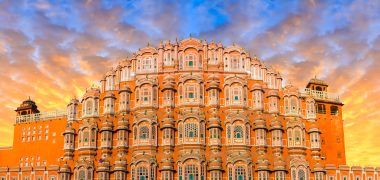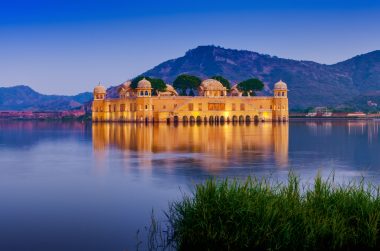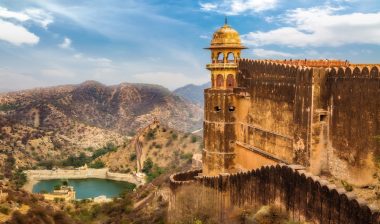When Prince Albert, husband of the British Queen Victoria, visited Jaipur in 1853, the then Maharaja of Rajasthan ordered the city to be painted pink as a sign of hospitality. Since then, today’s capital of Rajasthan in India has also borne the nickname “Pink City”. Especially at dusk, the magnificent facades of the lively old town shine in warm pink and red tones.
Vibrant Jaipur
Jaipur was founded in 1727 by Maharaja Jai Singh II, who moved his capital from Amber, now a suburb of Jaipur, a few kilometers further into the plain. Jaipur’s current old town did not grow organically over time, but was planned in advance as an implementation of the ideal Hindu cityscape and then built. The model was the legendary city of Ayodhya, which was home to the “Sun Dynasty” and thus the ancestors of the ruling house. Today, the bubbling old town is undisputedly the heart of the metropolis. The traffic is chaotic and noisy. Cars, rickshaws and cargo bikes jostle through the streets, with sacred cows, elephants and monkeys in between. Numerous goods are offered for sale in the bazaars and by hawkers on the street. And delicious North Indian street food can be tasted on every corner. Immersing yourself in the old town of Jaipur means experiencing the Indian way of life and culture up close. Hardly any other city in India offers this in such an intense way as Jaipur.
Places of interest in Jaipur
In addition to the pink old town, which was added to the UNESCO World Heritage List in 2019, there are numerous other sights to discover in Jaipur and the surrounding area. 


Delicious Jaipur
In addition to the numerous sights and the special atmosphere of the city, Jaipur also offers a wide selection of regional specialties. The various dishes and snacks are prepared practically always and everywhere in the city, so that it is not difficult for the visitor to get to know this part of Indian culture better. Jaipur’s countless restaurants serve dishes such as “palak paneer”, a curry with spinach and Indian cheese, or “tandoori chicken”, a chicken dish prepared in a special clay oven. If you want, you can even order typical dishes of the traditional palace cuisine of the maharajas in some restaurants and dine truly royally. But Jaipur’s street food is a very special experience. Exotically spiced snacks are prepared in the small food stalls and go straight from hand to mouth. Samosas, for example, are small triangular dumplings that are usually filled with potatoes or lentils and fried in clarified butter. Numerous other delicacies are offered all over the city and make a visit to Jaipur an experience with all the senses.
Jaipur, India: The 7 most important sights
Jaipur, the capital of the Indian state of Rajasthan, is also known as the “Pink City” and is famous for its magnificent palaces, historic forts and lively markets.
Here are the top seven must-see sights on your visit to Jaipur.
1. Hawa Mahal (Palace of the Winds)
The Hawa Mahal is an iconic structure of Jaipur, known for its impressive façade with 953 small windows.
The palace was built in 1799 and served the royal women, who could watch the hustle and bustle of the city from there without being seen.
2. Amber Fort
Located just 11 km outside of Jaipur, the Amber Fort is one of the most impressive forts in Rajasthan.
The fort is known for its magnificent palaces, halls, and gardens.
Particularly worth seeing are the Sheesh Mahal (Hall of Mirrors) and the light and sound show in the evening.
3. City Palace
Located in the heart of Jaipur, the City Palace is a mix of Mughal and Rajasthani architecture.
Today, part of the palace is a museum displaying royal artifacts, clothing, and weapons, while another part is still inhabited by the royal family.
4. Jantar Mantar
The Jantar Mantar in Jaipur is a UNESCO World Heritage Site and one of the largest astronomical observatories in the world.
Built in the early 18th century, it contains an impressive collection of instruments for calculating time, observing stars, and predicting celestial events.
5. Jal Mahal
The Jal Mahal (Water Palace) is a picturesque building located in the middle of Man Sagar Lake.
It’s a popular photo opportunity, especially at sunset, and offers a quiet retreat from the hustle and bustle of the city.
Unfortunately, the palace is not open to the public, but visitors can enjoy boat rides on the lake.
6. Nahargarh Fort
The Nahargarh Fort offers magnificent views of the city of Jaipur and is a popular spot for sunset visitors.
The fort used to serve as a hunting lodge for the Maharajas and is now a historical attraction with a small museum.
7. Albert Hall Museum
The Albert Hall Museum, also known as the Central Museum, is the oldest museum in Rajasthan.
It houses a diverse collection of artifacts, including sculptures, paintings, carpets, and weapons.
The architecture of the building is an impressive example of Indo-Saracen architecture.
The 3 most important museums in Jaipur
1. Albert Hall Museum
The Albert Hall Museum houses an extensive collection of antiques, artworks, and artifacts from Rajasthan and India.
The architecturally impressive building is a must-see for art and culture lovers. Address: Ram Niwas Garden, Jaipur, Rajasthan, India Opening hours: Daily 9:00 a.m. – 5:00 p.m. Admission: 300 INR for foreigners, 40 INR for Indians
2. Jaipur Wax Museum
The Jaipur Wax Museum at Nahargarh Fort displays realistically recreated wax figures of famous figures from Indian history and international celebrities. Address: Nahargarh Fort, Jaipur, Rajasthan, India Opening hours: Daily 10:00 a.m. – 6:30 p.m. Admission: 500 INR for adults
3. Anokhi Museum of Hand Printing
The Anokhi Museum in Amer is dedicated to preserving and promoting the traditional hand-printing process.
It shows the techniques and history of hand printing in Rajasthan. Address: Chanwar Palkhiwalon-ki-Haveli, Amber, Jaipur, Rajasthan, India Opening hours: Tuesday – Sunday 10:30 a.m. – 5:00 p.m. Admission: 80 INR for adults
Where to stay in Jaipur
Luxury Hotel: The Oberoi Rajvilas
Oberoi Rajvilas offers a royal experience with luxurious rooms, an expansive garden and top-notch amenities.
It is a palace hotel that promises an unparalleled stay. Address: Goner Rd, Jaipur, Rajasthan 302031, India
4-star hotel: Trident Jaipur
Located near the Jal Mahal, Trident Jaipur offers stylish rooms with magnificent views of the lake.
The hotel is known for its excellent service. Address: Amber Fort Rd, Jal Mahal, Jaipur, Rajasthan 302002, India
3-star hotel: Pearl Palace Heritage
The Pearl Palace Heritage is a boutique hotel known for its ornate and traditional décor.
Each room is individually designed and offers a unique experience. Address: 54 Gopal Bari, Ajmer Rd, Jaipur, Rajasthan 302001, India
Budget Hotel: Hotel Arya Niwas
Hotel Arya Niwas is a budget option in Jaipur, offering clean, comfortable rooms as well as a cozy restaurant.
Ideal for budget travelers. Address: Behind Amber Tower, Sansar Chandra Road, Jaipur, Rajasthan 302001, India
Popular Restaurants in Jaipur
1. Suvarna Mahal
Suvarna Mahal at Rambagh Palace offers fine Indian cuisine in a luxurious setting.
It is known for its royal atmosphere and excellent cuisine. Address: Rambagh Palace, Bhawani Singh Rd, Jaipur, Rajasthan 302005, India
2. Bar Palladio
Bar Palladio is one of the trendiest restaurants in Jaipur, offering a creative fusion of Italian and Indian cuisine.
The elegant European-style interior is unique. Address: Narain Niwas Palace Hotel, Kanota Bagh, Narayan Singh Circle, Jaipur, Rajasthan 302004, India
3. LMB (Laxmi Misthan Bhandar)
A legendary restaurant known for its vegetarian Rajasthani thalis and traditional Indian desserts.
LMB is a must-visit for foodies who want to sample authentic Rajasthani cuisine. Address: Johari Bazar Rd, Bapu Bazar, Jaipur, Rajasthan 302003, India
4. Chokhi Dhani
Chokhi Dhani is a traditional Rajasthani village resort that offers an authentic cultural experience.
Here, visitors can not only enjoy Rajasthani cuisine, but also experience folk dances, music, and crafts.
Address: 12 Miles Tonk Road, Via Vatika, Jaipur, Rajasthan 303905, India
Bibliography
- Information about attractions and museums: Tourism Rajasthan
- Google Maps
- Individual hotel and restaurant websites


